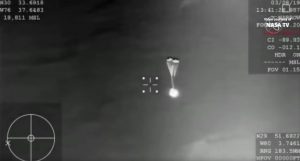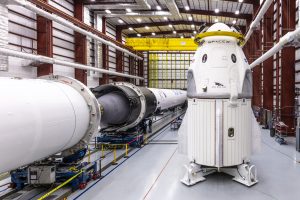Southern Research’s unique high-altitude HD video recording system provided NASA with dramatic close-up images of the SpaceX Crew Dragon spacecraft as it descended through Earth’s atmosphere for a splashdown in the Atlantic Ocean in March.
The Airborne Imaging and Reconnaissance System, or AIRS, mounted on a NASA WB-57F research aircraft flying at 18,000 feet, recorded the unmanned spacecraft on its March 8 return after a critical test mission to the International Space Station.
Tony Casey, engineering project leader for Southern Research, said the AIRS cameras filmed Crew Dragon’s descent for 12 minutes, capturing key moments such as when its drogue parachutes opened to slow the craft after reentry.
In addition, images recorded by the system’s infrared camera will allow NASA to estimate temperatures of various parts of the vehicle, he said.
“The high-definition video and infrared images captured by the AIRS platform on the WB-57 will help fill in the overall picture of how the spacecraft performed on a mission that could shape the future of the American space program,” said Casey, who is based in Houston, home of NASA’s Johnson Space Center.

Since the AIRS technology debuted in 2005, it has played an important role in many missions for NASA and other government agencies, said Michael D. Johns, vice president of the Engineering Division at Southern Research.
“When it comes to the issues of space flight, there is no margin for error,” Johns said. “Over the years, our team working on the AIRS technology has responded to each new challenge with innovative solutions that have helped advance the WB-57 program.
“This mission for NASA is another illustration of the versatility and value of the AIRS platform in support of a great partner,” he added.
DEMOSTRATION MISSION-1
Last month’s mission, known as Demonstration Mission-1, or DM-1, was seen as a significant step for SpaceX, the private space flight company, and NASA. The agency wants to launch its astronauts to the orbital laboratory from the U.S. aboard an American-built spacecraft — something it has not been able to do since retiring the Space Shuttle eight years ago.
The first-of-its-kind mission was designed to test Crew Dragon’s equipment, including its docking gear, as well as its systems for life support and re-entry, in an overall demonstration of its capabilities.
DM-1 began March 2, when a SpaceX Falcon 9 rocket lifted off from Kennedy Space Center in Florida. The spacecraft docked autonomously with the orbital laboratory on March 3. Throughout the flight, it carried a sensor-filled mannequin named Ripley to provide data about conditions inside the cabin.
Following Crew Dragon’s splashdown off the coast of Florida, scientists from NASA and SpaceX will now review the systems and flight data, including the AIRS recordings, to prepare for crewed flight.
Before that can happen, there will be an inflight abort test – and NASA’s WB-57 aircraft equipped with Southern Research’s AIRS turrets will again play a role in recording the critical moments in HD video for analysis.

The in-flight abort test will demonstrate the ability of Crew Dragon to safely deliver astronauts back on Earth in case of a problem after lift-off, Casey said.
After that, the AIRS cameras will capture images of Crew Dragon’s DM-2 mission, which will carry two NASA astronauts to the International Space Station. The milestone mission is targeted to take place this summer.
“We consider it an honor to support NASA and advance its core mission of exploration and discovery because that is exactly what Southern Research is all about,” Casey said.
EVOLVING TECHNOLOGY
Southern Research provides ongoing support of the AIRS platform on the WB-57F research planes based at Johnson Space Center under a contract with NASA that stretches back to 2011.
Southern Research’s engineers began working on the AIRS technology in 2003 in an effort to develop a high definition video imaging system capable of monitoring the NASA STS-114 Return to Flight shuttle launch following the Columbia accident.
Since the AIRS-equipped WB-57s were first used to provide full motion video of that mission in 2005, they have since monitored numerous launches and re-entries for government agencies such as NASA, as well as commercial launches.
From a height of 50,000 feet, the AIRS technology aboard a pair of NASA WB-57s captured spectacular visible light and infrared images of the total solar eclipse over the U.S. in August 2017.
Don Darrow, a Southern Research communications engineer who operated AIRS in one of those planes that day, was on the support team for the DM-1 mission.